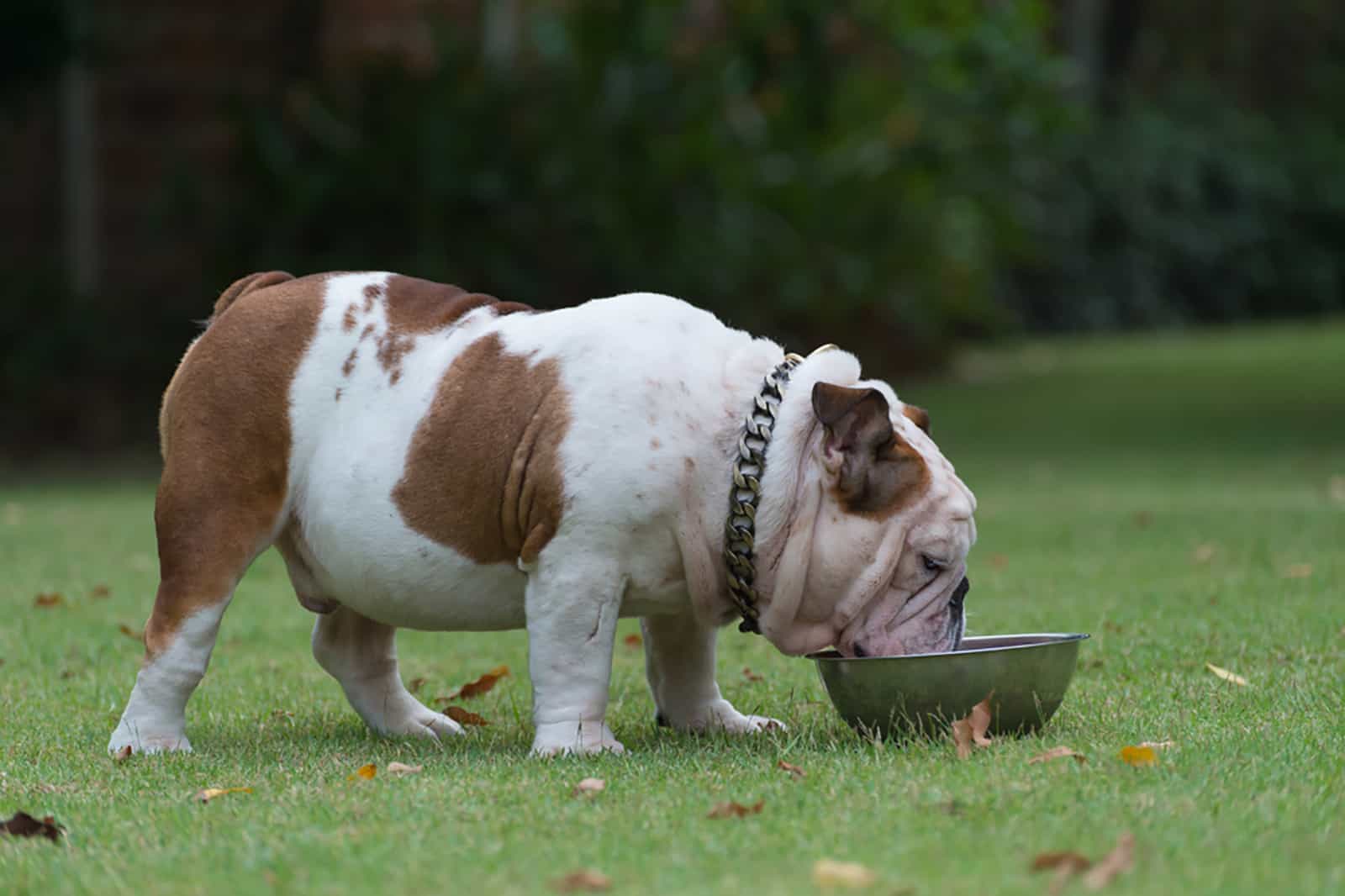If you already own an English Bully pup or you’re thinking of getting one, I’m sure you will find this English Bulldog feeding chart very helpful.
These pups are adorable four-legged companions that are very attached to their owner (they’ll probably end up sleeping right next to you).
English Bulldogs come in a variety of colors, including white, chocolate, bi-color, tri-color, lilac, blue, merle, and other shades and patterns.
Even though they differ in the shade of their coat, all these pups deserve the same amount of care, especially when it comes to feeding, which is the foundation of healthy growth and development.
English Bulldog Feeding Chart: Overview
[table id=547 /]
English Bulldog Puppy Feeding Chart (2 weeks)
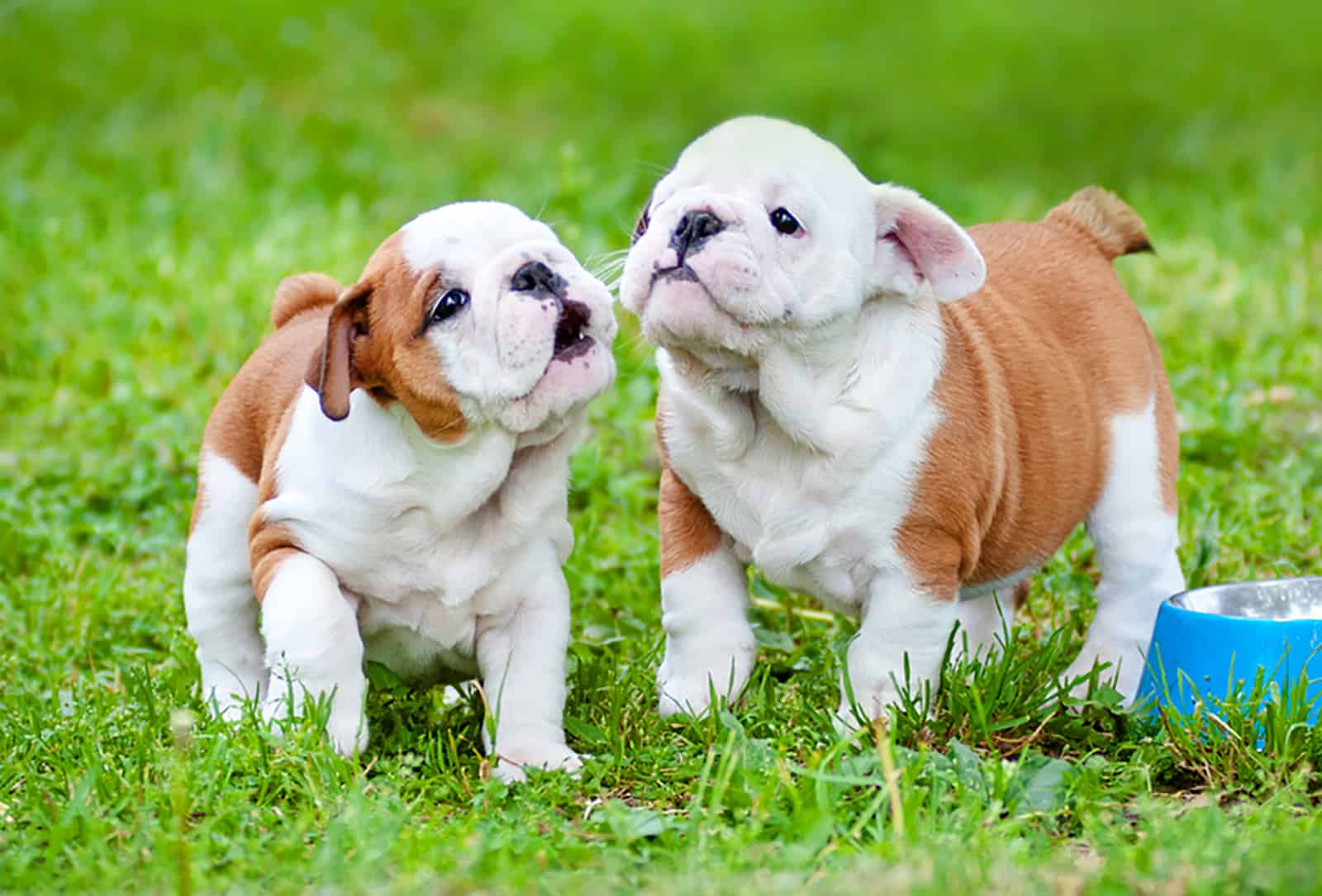
Newborn English Puppies don’t require much care and attention from their human owner during the first few weeks of their life.
At this point in life, puppies should be with their parent, the English Bulldog mother, which is breastfeeding them on demand.
There is no need to introduce any other type of dog food except mother’s milk during this period.
However, there are certain situations in which the dog owner or a breeder (depending on whether the puppies are raised at the owner’s home or in a kennel) should react.
If the puppy was separated from the mother for some reason, or the mother’s supply of milk isn’t enough to feed all the pups, the owner should provide additional food (puppy milk replacers/formula), along with water to the puppies that aren’t getting any/enough food.
Of course, if such a thing occurs, you should seek advice from a vet on what steps to take next. A newborns’ tummy is too sensitive to be fed without careful consideration.
English Bulldog Puppy Feeding Chart (4 to 6 weeks)
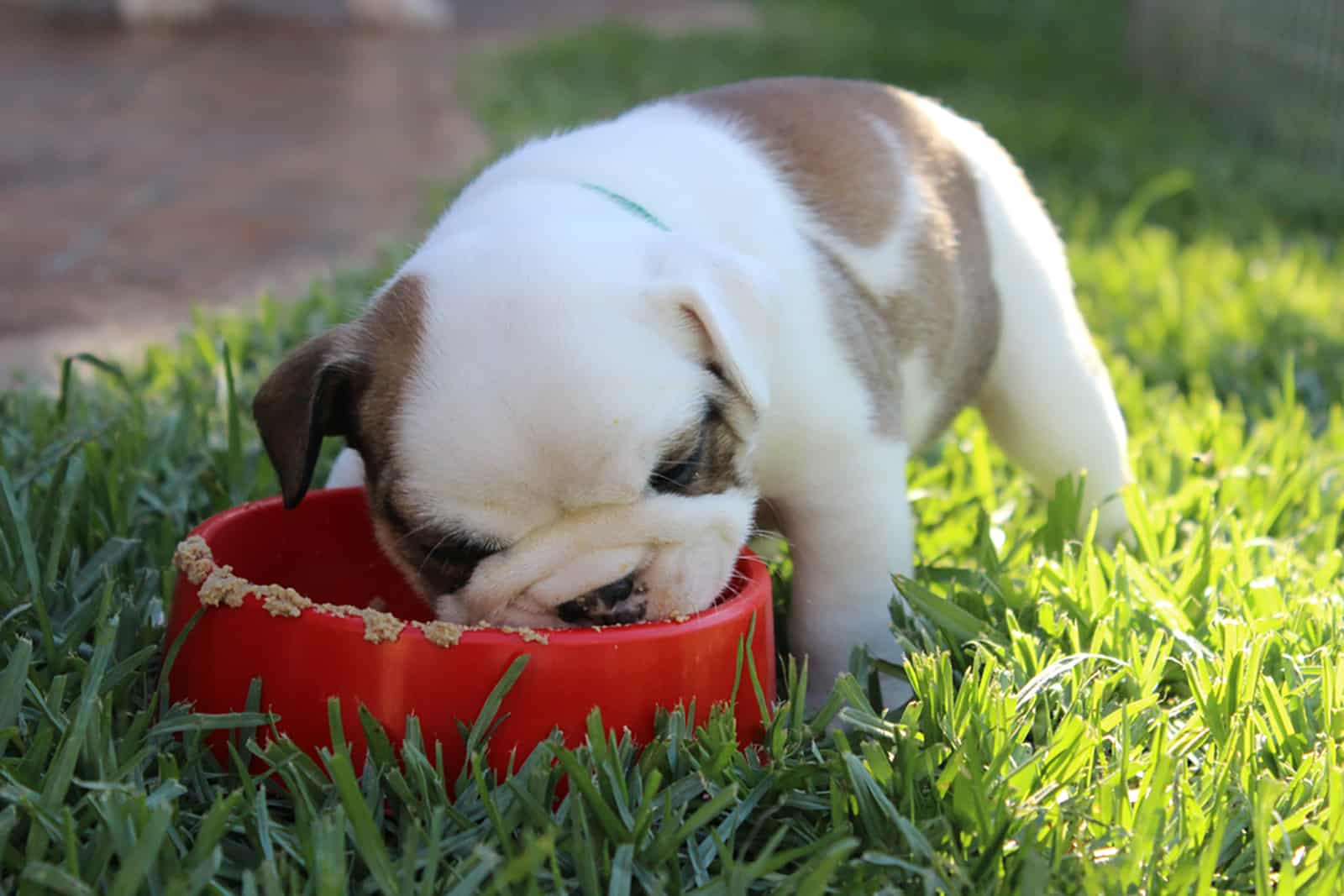
Although puppies at this stage are still extremely close to their mother, they are slowly starting to explore the world around them.
An English Bulldog puppy’s activity level is increasing, and they’re trying to move around and check out their surroundings.
At four weeks of life, puppies might not yet be ready to try any other food. However, they will start teething at this point, so the mother might begin the weaning process.
At around six weeks of life, puppies should already have an almost full set of baby teeth, which will make nursing a very painful experience.
How Do You Wean Puppies Off Mother’s Milk?
As soon as you notice that the puppies’ mother is uncomfortable during breastfeeding sessions or that she’s trying to back away, you should help her wean her puppies.
The best way to switch from nursing to solid foods is to separate the English Bulldog mom from her puppies for an hour, two or three times a day.
You should introduce puppy food to the doggies before you completely cut off breastfeeding in order to ease the process of transition.
English Bulldog Puppy Feeding Chart (8 to 10 weeks)
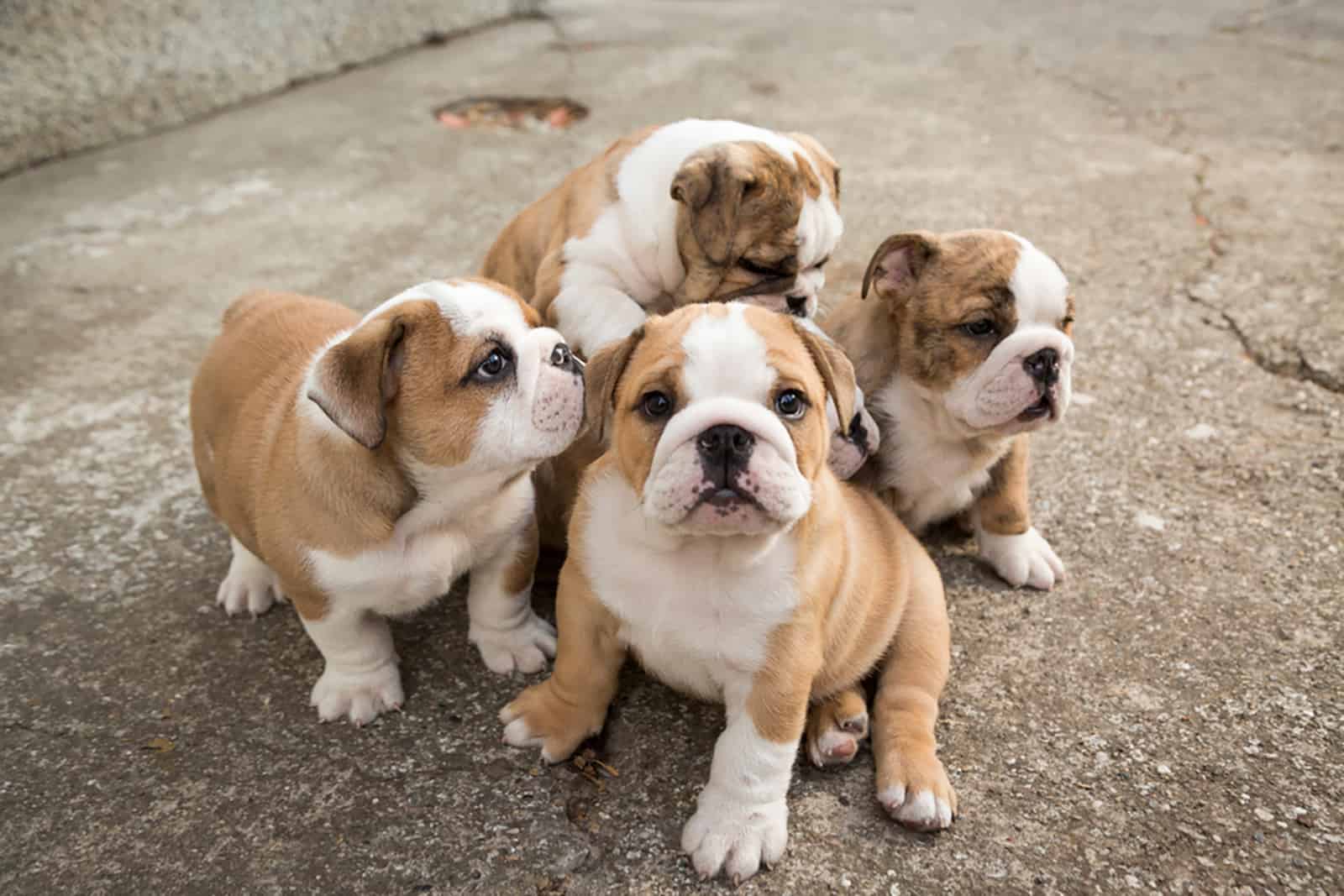
A two-month English Bulldog puppy is completely ready to eat puppy food, and will need to continue to be raised by the owner. That’s why eight-week puppies are usually given for adoption by the breeder.
The mother’s milk or puppy formula isn’t the essential source of nutrients anymore.
Actually, this type of diet isn’t suitable for older pups as it might not contain enough nutrients for doggies in development that are becoming very active as well.
Your pup might not eat much during the first few weeks of being on solid food, so one, to one and a half cups will be more than enough (divided into three meals during the day).
Once they turn ten weeks of age, the English Bulldog puppy’s appetite might increase as well. If you notice that your pup is eating everything from its bowl shortly after you give it food, it might be time to check its weight.
The average weight during this stage should be somewhere between 12 and 15 lbs. If your pup has less or more pounds, you should consult with a vet for further feeding instructions.
RELATED: English Bulldog Growth Chart — When Will My Pup Stop Growing?
English Bulldog Puppy Feeding Chart (12 to 16 weeks)
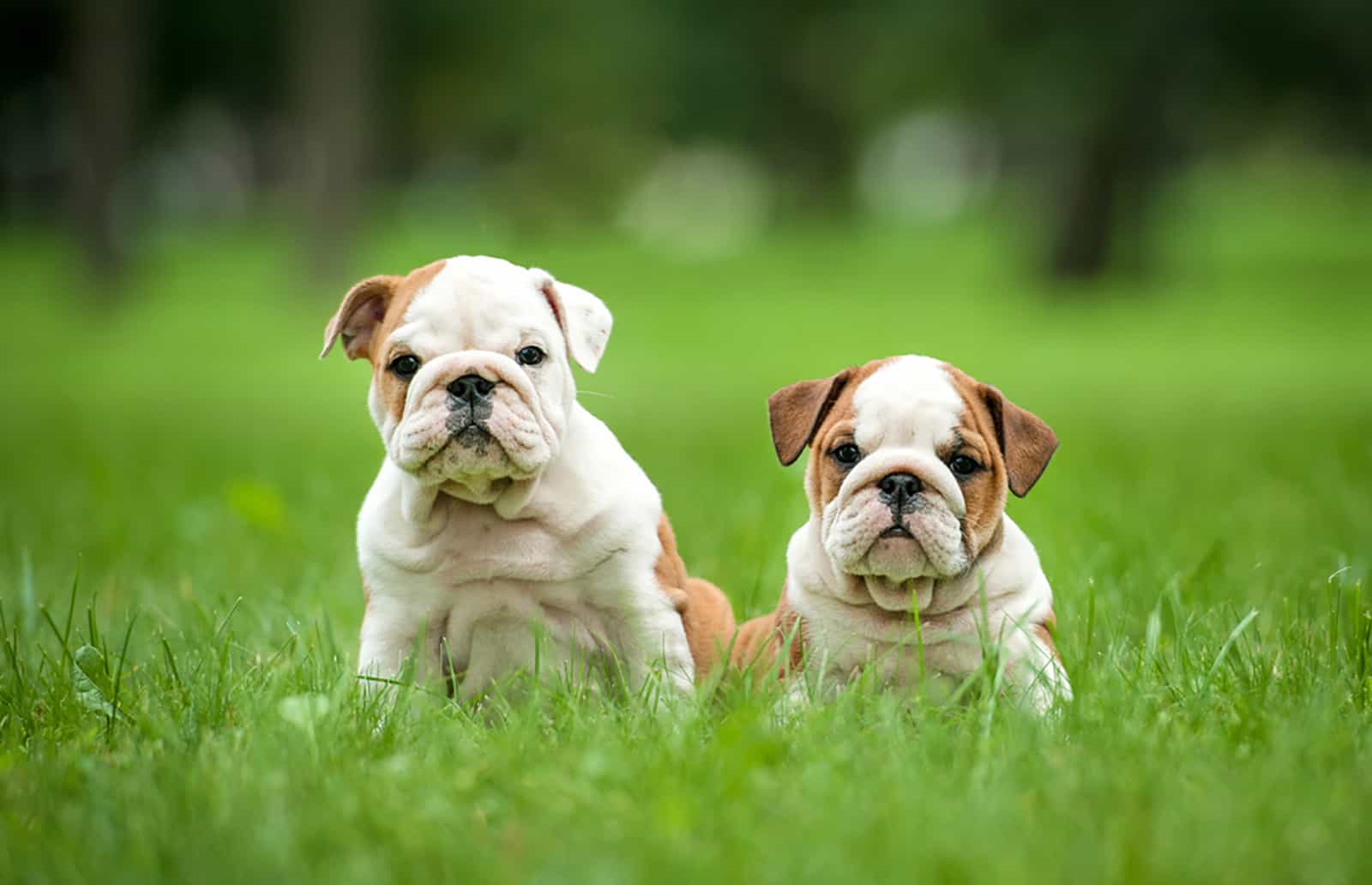
During this period, you will start to notice that your English Bulldog puppy requires a little bit more food than ⅓ of a cup per meal, even though you’re feeding them three times a day.
The amount of food your pup needs will depend on the level of its activity. If it is more active and loves to run around, there are high chances you’ll need to start feeding it a bit more than one-third of a cup of food.
The puppies are developing, and are growing bigger and stronger week after week, so don’t be surprised that their need for food and nutrients is increasing as well.
However, this period is very challenging for both puppies and their owner.
There’s a thin line between providing your little pup with enough food and overfeeding it, which is why it’s better to talk to a dog expert (vet) if you’re not sure how much food a meal should contain rather than give in to your dog’s cravings.
Remember that pups are just like people when it comes to food. If we love it, we just can’t stop eating, even though we’re already full.
If you give in, you’ll soon have an overweight puppy with a high risk of numerous health issues related to obesity.
English Bulldog Puppy Feeding Chart (5 to 10 months)
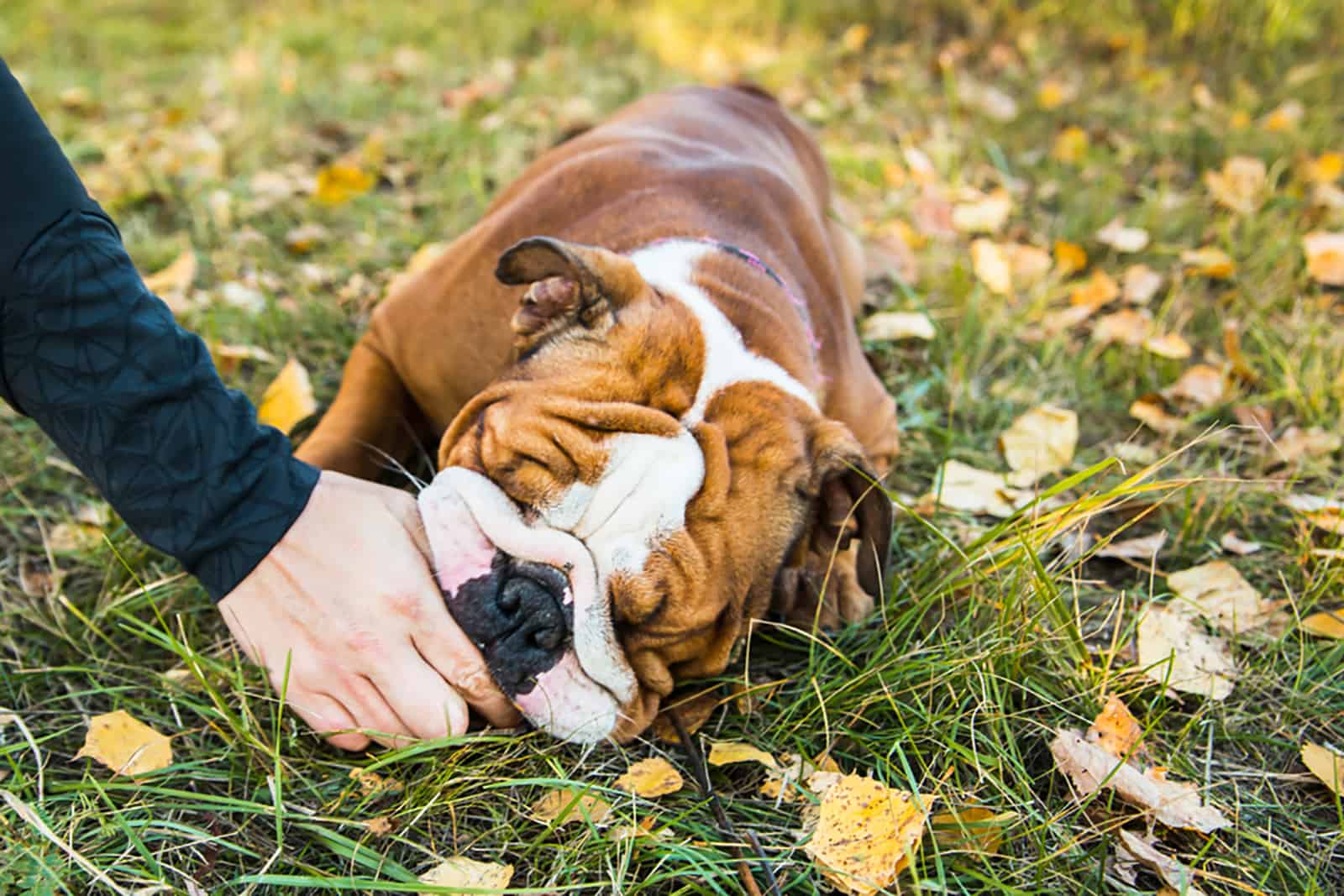
This is the period of intensive growth and development for English Bulldog puppies. It’s believed that during this time, puppies usually gain 10 to 12 lbs.
You can expect your pet to eat between 1 and 1.5 cups per day, divided into two meals. Some pups might even eat 2 cups as they get closer to their tenth month, but only if the vet recommends it.
The amount of food varies on the individual development of each pup. Some English Bulldog puppies might be larger than others, so it’s no surprise that they require more food.
English Bulldog Puppy Feeding Chart (10 to 12 months)
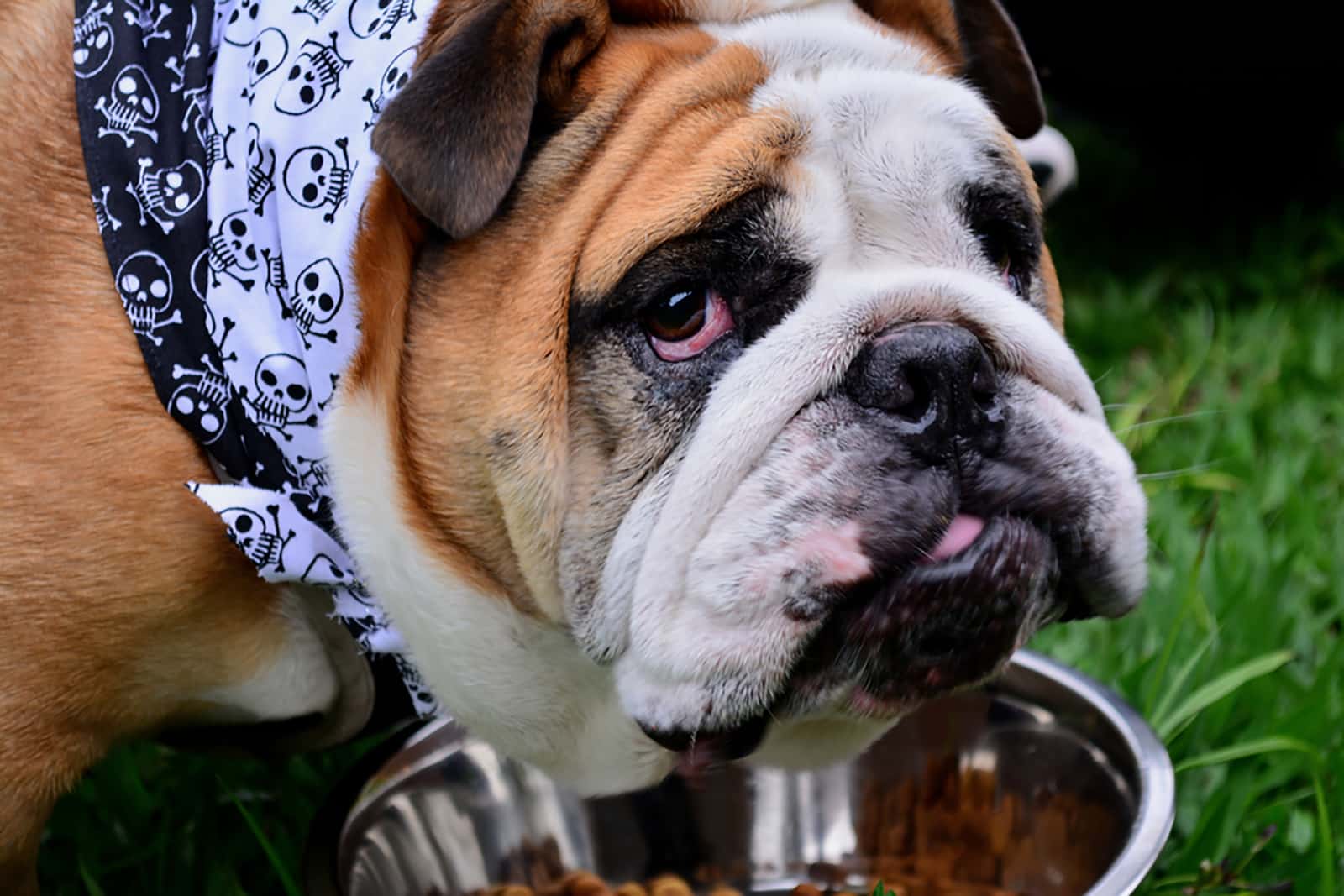
This is the part when your English Bulldog puppy is slowly but surely turning into a young adult dog, which is why it’s necessary to switch to bigger portions of food until they’re one.
Of course, if your pup is small, you won’t feed it the same amount as a bigger and sturdier English Bulldog.
One and a half cups on a daily basis might be acceptable at 10 months of a pups’ age, but it would be good to raise that to two cups until they officially turn one.
Food is essential for the healthy development of your puppy. However, don’t forget that treats are also a part of the meal as they satisfy your dog’s hunger and cravings at the same time.
Again, if you’re not completely sure that your pup is getting enough food, or you notice that your pet is quickly gaining/losing weight, you should contact a vet and check their recommendations.
English Bulldog Feeding Chart (12 months and above)
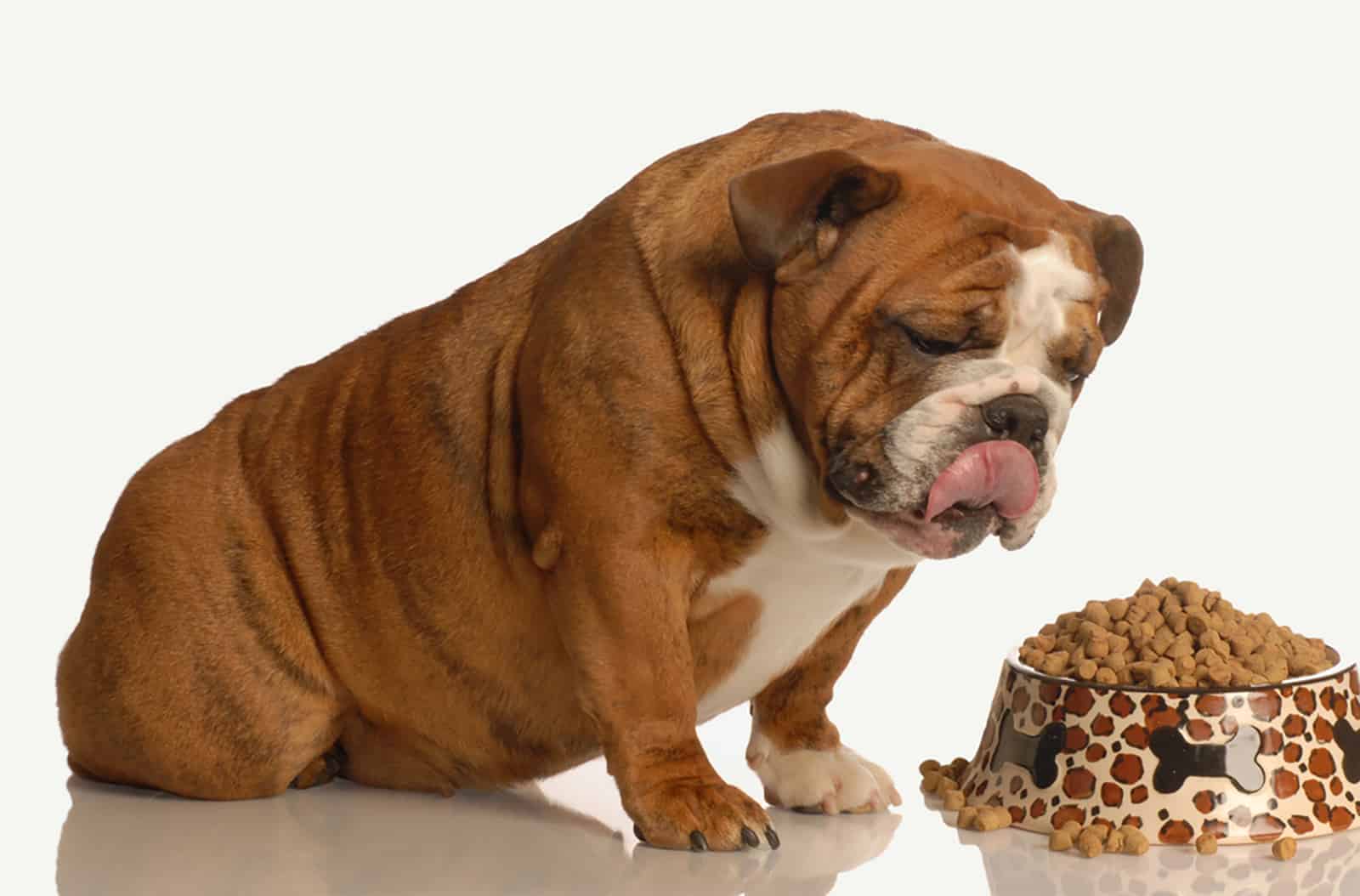
Congratulations… at this point, you’re the proud owner of a wonderful adult English Bulldog that is still as cute as it was when it was a puppy.
However, as you might notice, your big pup requires more food because it serves as the energy that enables him to enjoy his activities, and helps him develop in a healthy way.
A healthy diet based on nutrients and healthy fats can strengthen your dog’s immune system, and improve bone density and joint health as well.
Finding the right adult dog food for your English Bulldog is essential, as well as the amount you’ll give on a daily basis.
Can Adult English Bulldogs Eat Puppy Food?
To be honest, the answer is both yes and no.
I know this sounds confusing, but essentially, your adult canine can eat puppy food without any great consequences.
However, this shouldn’t become regular practice as it might have a negative impact on its overall health in the long term.
Puppy meals are specially formulated to meet the nutritional needs of growing puppies.
As soon as your pup becomes a full-grown canine, the food they had when they were little will not be of any particular use.
If you feed your dog puppy food occasionally, without turning it into a regular habit, nothing wrong will happen. However, I’d still strongly advise you against it.
Recommended Calorie Intake For An English Bulldog Puppy
The establishment of a proper feeding schedule is one of the greatest things you can possibly do for your English Bulldog pup.
Although it doesn’t seem such a big deal, a regular schedule, including the amount and the type of food used, is the foundation of a puppy’s health.
Unfortunately, English Bulldogs are quite similar to French Bulldogs when it comes to risks of certain conditions and diseases, including obesity.
READ NEXT: Male Vs Female French Bulldog: Which One Would You Choose?
If your puppy consumes an excessive amount of food, it runs the danger of gaining extra weight, which could have a negative impact on its growth and development.
However, if your puppy isn’t getting enough food, it might be malnourished and have an increased risk of being sick since it is not getting enough nutrients.
How Many Calories Does My Pup Require?
In order to determine the precise amount of calories that your puppy needs each day, you will first need to take into account its weight.
That is why you will need to calculate their energy requirements, also known as the Resting Energy Requirements (RER).
RER is usually determined by taking the English Bulldog’s weight (in the metric system) raised to 3/4 and then multiplying that number by 70.
After you receive a certain number, you will need to multiply it additionally by two, and then you’ll get the final number of calories your pup requires on a daily basis.
Feeding Your English Bulldog Kibbles And Wet Food
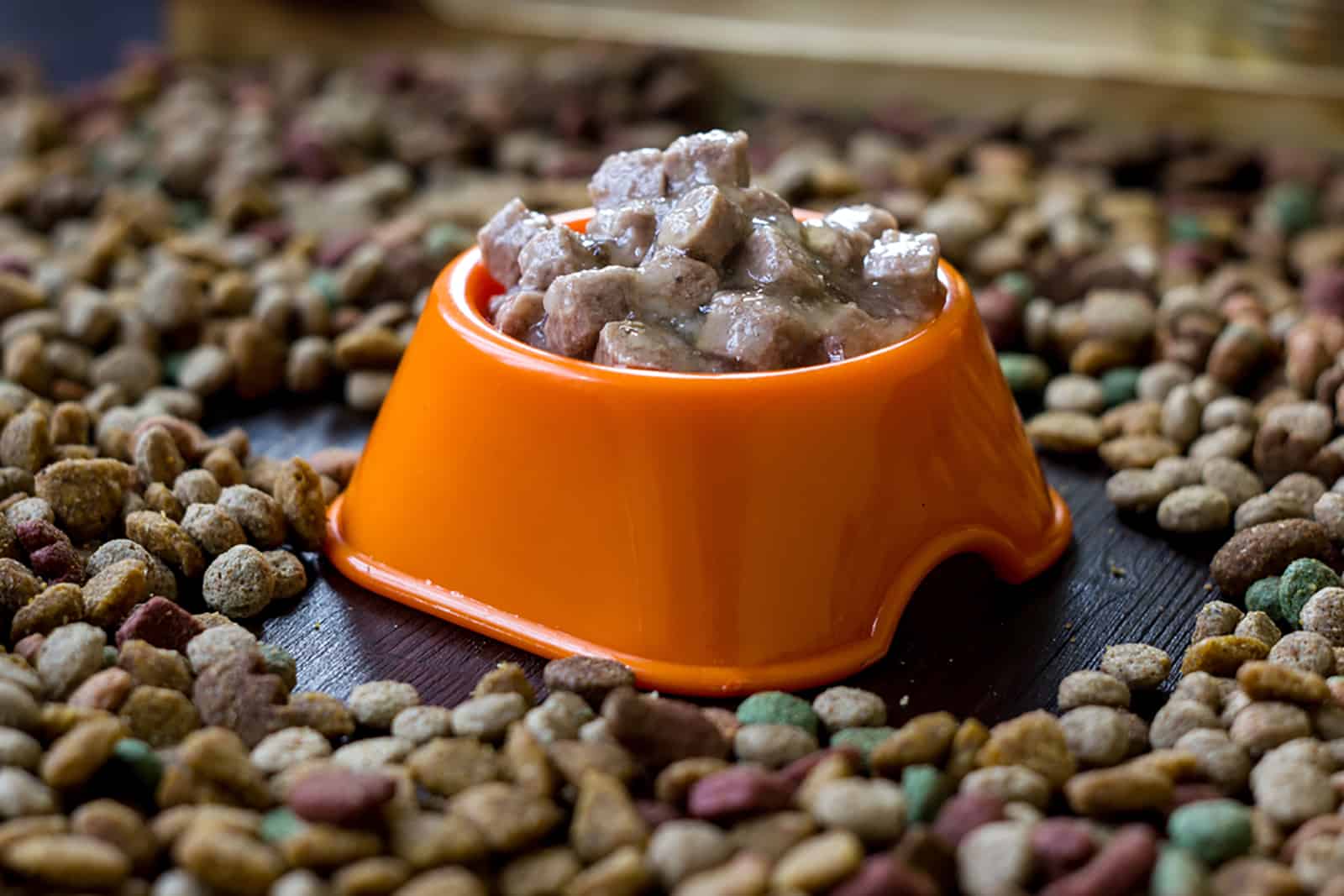
Wet and dry dog food are two of the most common types of meals that are used by almost every pet-friendly household, not only in the United States, but also in the rest of the world.
Both of these types are commercial, which means that they can be found in almost every market in the United States.
There are many brands available on the market that differ not only because of their package, but also the ingredients that each of them contain.
Dry Food
Dry kibble is usually used as a full meal, but some people might even use it as dog treats, especially if it is one of the favorite foods on their pup’s menu.
This type of food is popular among dog owners as it’s practical, economic, and filled with nutrients that are essential to your English Bulldog, or any other dog breed for that matter.
However, although this type of food has plenty of benefits, there are certain things you should pay attention to.
First of all, there are many types of dry food available on the market, and it’s essential to choose only the ones that are suitable for your canine.
Also, not every type of dry food is good for your English Bulldog, so make sure to read the nutrition label and the ingredients list before you make the purchase.
Make sure the dry food you buy for your English Bulldog is made particularly for growing pups as well as medium and big breeds when you go to the store to get it.
Wet Food
Essentially, it’s all about weighing the pros and cons of wet and dry food for English Bulldogs, as well as your personal preferences.
Some dog owners just don’t like the potential mess that is caused by wet food, which contains a high percentage of water.
However, there are owners who will put that aside once they see that their pups are getting more animal protein as it contains more meat.
Wet food is also a great way to keep your pet hydrated, especially if it is in both the physical and mental development processes.
However, after it has been opened, it must be stored in the refrigerator in order to prevent spoilage.
Check the product’s list of ingredients before making a purchase of either dry or wet food in order to confirm that it is made with high-quality protein, and does not include any fillers, additives, or preservatives.
Raw Food
The number of canine owners who are switching their pets to raw feeding has been increasing during the last few decades, especially since it has been claimed that raw food has plenty of health benefits.
It’s considered that this type of diet improves the English Bulldog’s overall health, including skin irritations, fur damage, and hair loss (all of which might be caused by the lack of certain vitamins or proteins).
The English Bulldog’s digestive tract is built to consume both meat and bones, which is why they won’t have any certain issue getting used to this type of food.
However, even though it can be beneficial, raw food can also be quite risky for your pet as it’s uncooked, meaning that bad bacteria have the chance to enter your pet’s body through raw ingredients.
Also, if you plan on feeding your puppy a raw diet, you should check to make sure that there are no tiny bones in the food, so your pet doesn’t get seriously hurt.
How Do You Avoid Potential Hazards Related To Raw Food?
Your doggie’s health is of the utmost importance, not only for you, but for your whole family as well, for sure.
Even though raw food is becoming very popular and recommended by many, there’s still some controversy behind it.
However, if you’re worried about whether your dog is eating healthy or not, you can do your own research and pick only the brands/people that you trust.
Find companies that put money into research, preferably ones that do it through non-traditional veterinary organizations.
Also, talk to your veterinarian about the best way to give your puppy a raw-food diet, and get their recommendations on how to do it.
Which Food Is Recommended For English Bulldogs?
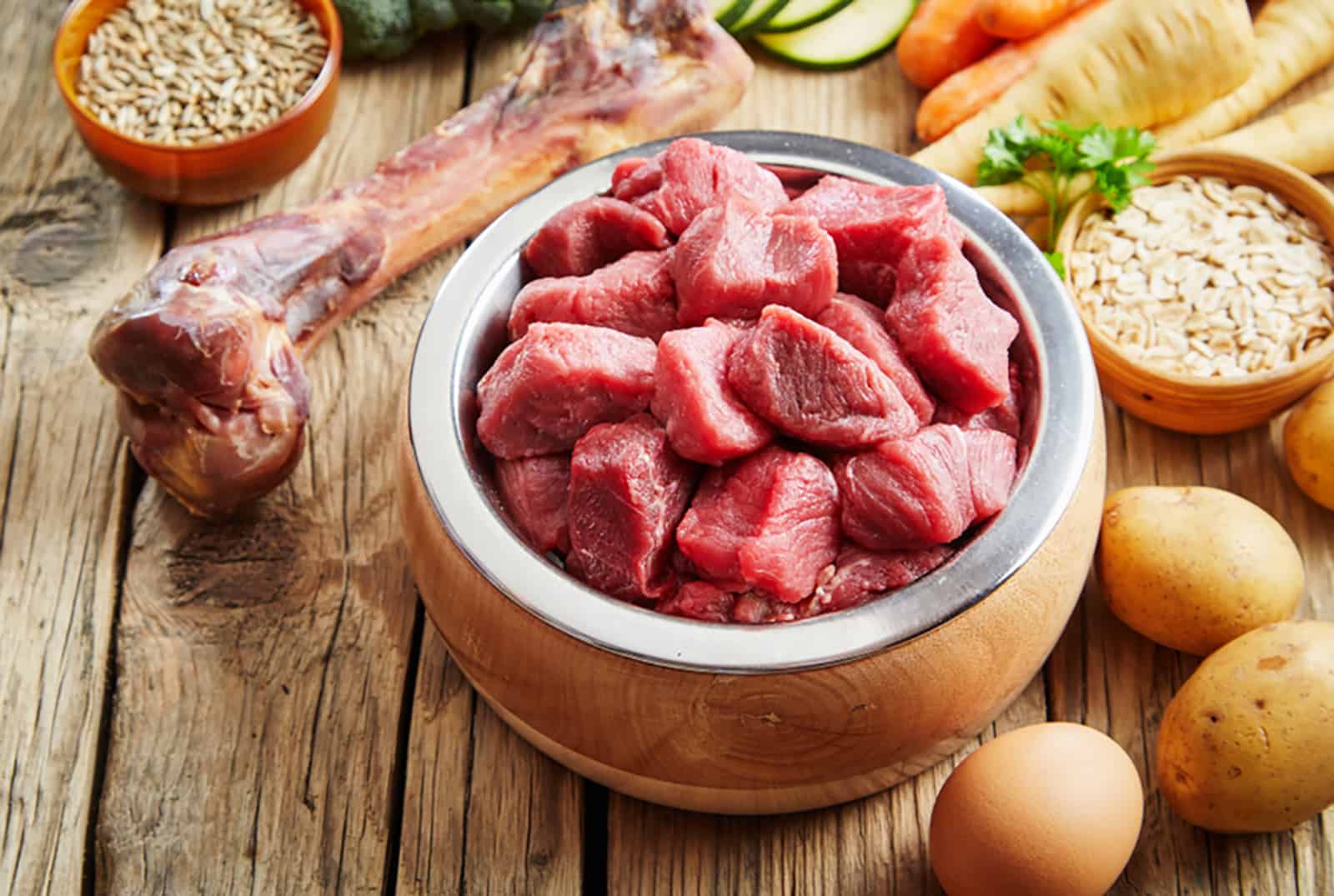
Human foods have the vital nutrients that can support your puppy’s growth and development, in addition to providing health advantages like healthier teeth, stronger joints, and immunity to allergies.
English Bulldogs might not be very similar to Frenchies in terms of physical appearance, but these two dog breeds follow quite a similar feeding guide as they’re both small to medium canines with proneness to obesity.
Human foods can be of great benefit to English Bulldogs, but only if they’re taken in certain amounts, and if they’re suitable for dogs.
The following is a list of foods that are great for humans, and may also be fed to your English Bulldog:
• Tuna – This type of fish is suitable for English Bulldogs as it contains omega-3 fatty acids and a great number of proteins. However, it should be taken in small amounts as it contains mercury, which might be detrimental to their health.
• Yogurt – If your English Bully tolerates dairy products, yogurt without added sugars will be an excellent source of protein and calcium as this food is high in both.
• Coconut – This is one of the best dog foods for a Bully’s metabolism as it supports its digestive system. Also, coconut helps its fur look even more beautiful and shiny.
• Cashews – They’re one of the rare types of nuts that aren’t toxic for pups if they’re taken in the right amount. Many Bulldog owners use cashews as an occasional treat because it contains fibers, proteins, and healthy fats.
• Pork – This type of meat can be a good choice for English Bulldogs, but only if it’s cooked because uncooked pork might be a potential hazard for both people and canines.
• Fish – Although we already mentioned tuna, it’s important to say that fish, in general, is very beneficial for both young and old English Bulldogs.
• Eggs – Your four-legged friend will benefit tremendously from the nourishment that eggs provide. Healthy fats, proteins, and vitamins contribute to the overall health of your pet and increase its energy levels.
• Cheese – This is one of the recommendable foods that should be taken in moderate amounts as it might be too fatty for your pup (depending on the type of cheese, of course).
• Turkey – This type of meat appears quite often as an ingredient in commercial dog food. That is because turkey contains nutrients that are essential for the development of canines, including proteins and phosphorus.
• Milk – It’s not forbidden, but milk should be taken in smaller amounts, especially until you’re completely sure that your pup’s stomach can tolerate dairy products. However, I’d still recommend you go with yogurt instead as it contains probiotics as well.
• Quinoa – It’s considered a great replacement for wheat, corn, or even soy, which are typically found in dry dog food.
Although it’s not harmful to canines, you should introduce quinoa into your dog’s diet slowly until you’re sure that it doesn’t have any negative impact on its digestive system.
• Brown rice – Not only is it safe for dogs, but brown rice is also highly recommendable as it offers nutrients instead of simple carbohydrates that only increase the number of calories.
Which Food Isn’t Recommended For English Bulldogs?
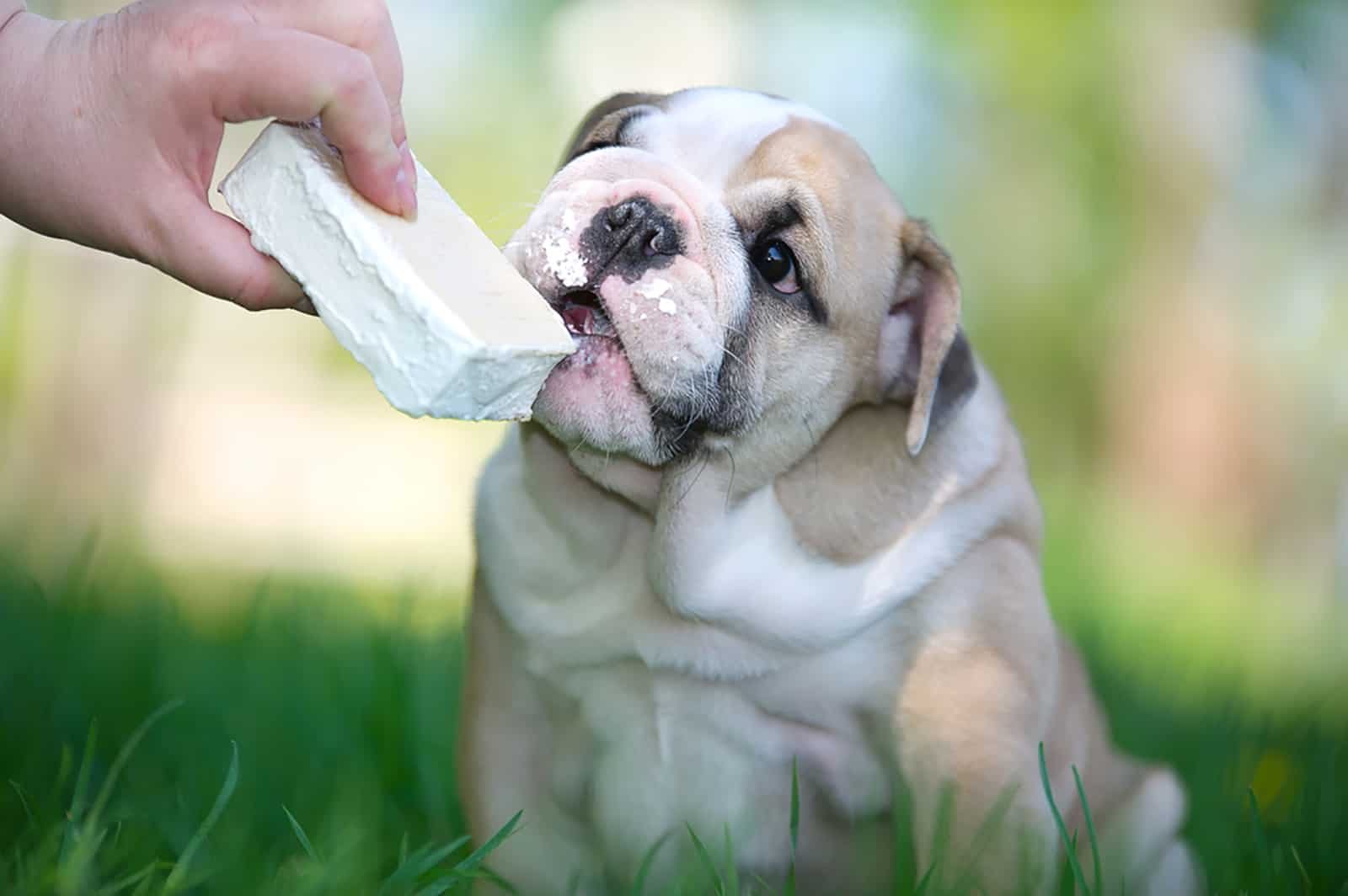
Certain human foods aren’t recommended for English Bullies, nor for any other breed for that matter as it might negatively impact their health.
The foods that are mentioned in the list below contain some specific components that might be hazardous to English Bullies and create some major health problems:
• Almonds – These nuts aren’t recommended for dogs for two reasons: the first one being the amount of fat that is unhealthy for pups. The second reason is the inability of canines to digest almonds, which might cause stomach issues.
• Ham – This is considered a fatty, processed type of food that contains salts and causes stomach issues for English Bulldogs. The amount of fat can also lead to some serious conditions, including pancreatitis.
• Ice cream – I’m sure this is quite self-explanatory, but I’d just like to emphasize once again that sugar shouldn’t be given to canines in any form as it might cause severe damage to your pet’s health.
• Chocolate – Aside from sugar that is contained in chocolate, there’s also theobromine – a dangerous chemical that has a negative impact on vital organs, such as a canine’s heart and kidneys.
• Garlic – Along with onions, garlic isn’t recommended for canines at all as even the smallest amount might be toxic for them.
• Cinnamon – According to the American Society for the Prevention of Cruelty to Animals (ASPCA), this spice is okay for canines and can be taken in small amounts. However, I’d rather avoid it if possible.
• Macadamia nuts – They’re poisonous, and they produce symptoms such as high temperature, vomiting, convulsions, involuntary shaking, etc.
Of course, it’s important to mention that non-recommendable human foods include all sorts of beverages, especially coffee, soda, and alcohol, that can be detrimental to the health of your pup.
Any type of added sugar (sweets, cakes, etc.) can have an extremely negative impact on a dog’s health to the point that it could become even life-threatening.
Transitioning From Puppy Food To Adult Dog Food
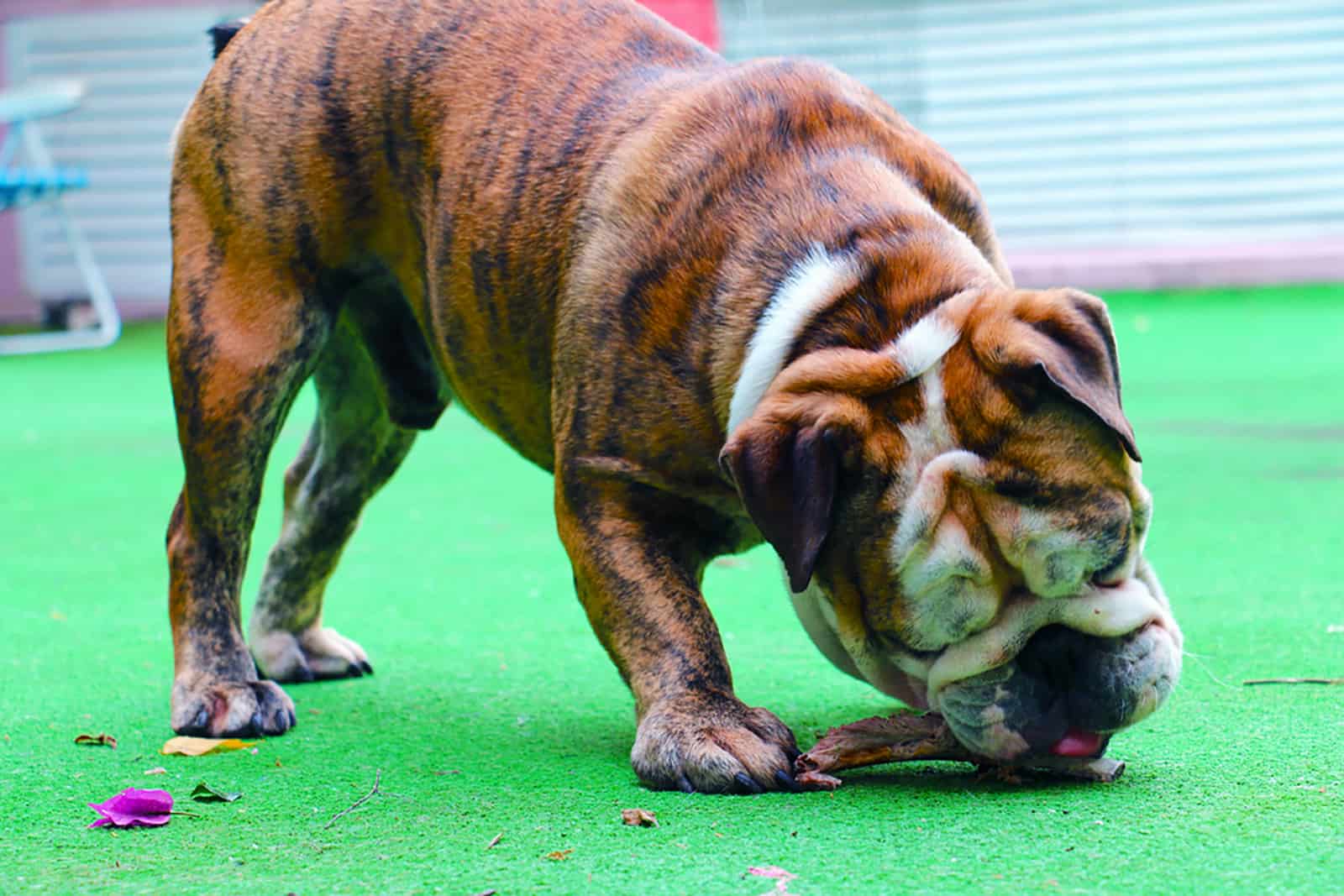
A one-year-old English Bulldog is completely ready to switch from puppy food to adult dog food if there aren’t any health indications suggesting otherwise. In that case, you should follow the vet’s recommendations.
If your English Bulldog puppy is healthy, it can start with adult food at 12 months of age, but under certain conditions.
The transition should be made gradually, meaning that you should begin by adding only around 25 percent of adult food during the first week of transition, increasing it to 50 percent for the next few days, and continuing with 75 percent for another few days until the puppy food is completely gone from its plate (bowl).
I agree that this takes some patience and hard work, but just remember that your pup will greatly benefit from this change.
Why Is Puppy Food Not Suitable For Adult Dogs?
Food for puppies is generally based on calories as it needs to accommodate the growth of the canine.
However, once your pup reaches its final size (height), puppy food will no longer be necessary, and it might just increase the weight of the dog without offering enough nutrients.
Adult dog food is specifically produced to fit an adult dog’s needs, which is why it contains proteins, minerals, vitamins, and other nutrients essential to the dog’s development.
Since English Bulldogs have such a propensity to be overweight, you really do not want to keep them on puppy food any longer than is absolutely necessary.
Can I Overfeed My English Bulldog?
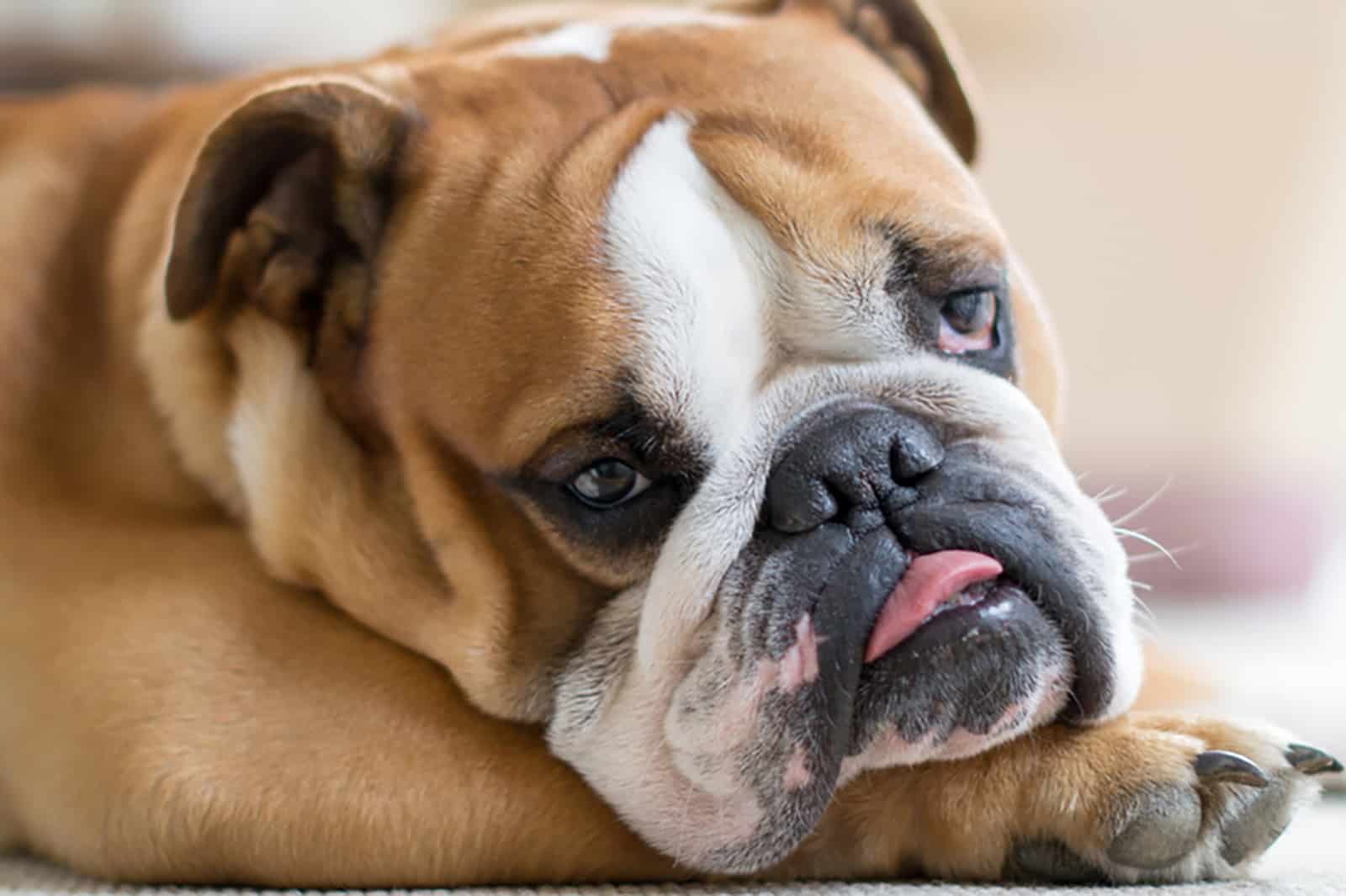
Unfortunately, this can happen even to the most caring Bulldog owners, so even if you do overfeed your English Bullie, you shouldn’t feel bad.
These canines might show signs of hunger even shortly after they eat, which is why most owners give in and offer more food.
That is why it’s essential to keep up with the feeding schedules and routines.
Here are some of the most common negative effects that overfeeding might cause to your English Bulldog:
• Digestive discomfort (bloating) and stomach pain
• Sudden weight gain
• Joint pain
• Breathing difficulties
• Obesity
Because you always give in to their pleading and give them a treat, their appetite increases, which makes it more difficult to get back to the feeding routine.
Canines are then stuck in a loop of believing that they can obtain as much food as they want without an understanding of how this might impact their health.
Because of this, you are unintentionally teaching your dog to be perpetually hungry, which is not in either of your best interests.
Tips For Feeding Your English Bulldog
Dogs aren’t capable of self-regulating their eating habits, which is why dog owners need to take care of the feeding schedule and amount of food their pets can eat during one meal.
It’s quite challenging to decide how much food is enough, but there are certain eating patterns that are recommended by more experienced owners and dog experts.
Here are some of the most common guidelines for feeding your English Bulldog:
• Follow the recommended pattern of meals according to the pup’s age (don’t add or take any meal from their feeding schedule)
• Consult your vet on dog meals that are high in grain content as they’re usually not recommendable. Canines can have a difficult time digesting grains because it is not a natural meal for them.
• Check the food container for specific instructions from the manufacturer on the serving size that is advised according to your dog’s weight
• Put your trust in your gut feelings. If you believe in yourself and in your judgments, you will easily get a sense of how much food is enough for your pet
Medical Reasons Behind An English Bulldog’s Constant Hunger
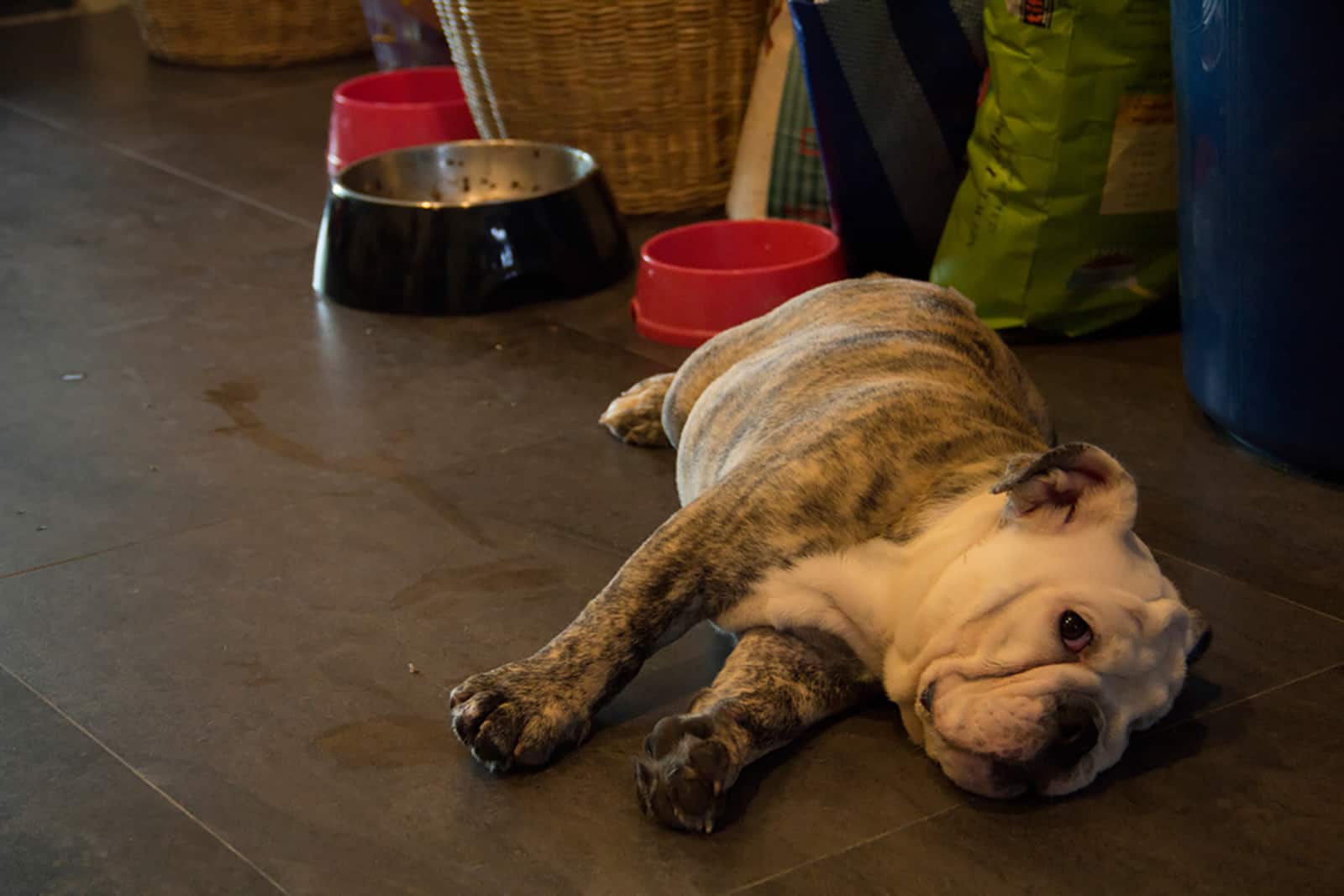
If your English Bully wants to eat more than what you serve it according to their feeding schedule, the first thing you should do is take him to the vet for a checkup.
There might be a medical issue behind your pet’s constant hunger, but there are also high chances that the dog is just an avid food lover and can’t get enough of it.
If your pup’s veterinarian concludes that your Bulldog is in good health, you should just stick to the eating routine, and not give in until the pup gets used to the amount of food it receives.
However, if the vet finds a relation between a medical issue and the constant hunger of your pet, you should strictly follow their instructions rather than general recommendations.
The most common medical issues related to an English Bulldog’s hunger are:
• Diabetes
• Inability to absorb nutrients from food
• Hyperthyroidism
• Contraindications of certain meds your pup might be taking
• Bacterial infection
• Lack of proteins
• Exocrine Pancreatic Insufficiency
Health Issues Caused By Improper Feeding Of English Bulldogs
Hip Dysplasia
Hip dysplasia is a developmental disorder that affects dogs, and it is most commonly seen in large types of canines.
RELATED: Tallest Dog Breeds: 15 Largest Dogs On The Planet
This condition is brought on by a hip deformity, which leads to joint laxity, also known as looseness. Joint laxity can cause discomfort, mobility difficulties, and other bone-related medical conditions.
Even if the condition is usually present from a young age, many canines won’t display clinical indications until they are older, even though the issue has always been there.
Although English Bullies aren’t a giant dog breed, their proneness to obesity and joint issues make them susceptible to hip dysplasia.
Hyperthyroidism
The disease known as hyperthyroidism is brought on when the thyroid gland of your pet generates an abnormally high volume of hormones.
In dogs, hyperthyroidism is a condition that is extremely dangerous, but relatively uncommon. Hyperthyroidism is typically the result of thyroid carcinoma (an aggressive and fast-growing cancer of the thyroid).
Its main symptoms include increased thirst and appetite, vomiting, heart murmurs, sudden weight loss, breathing difficulties, etc.
Diabetes
Diabetes is a medical condition that is characterized by a lower quantity of glucose (also known as sugar) in the blood of the canine.
Diabetes is characterized by either an insufficient amount of insulin being produced by the canine’s body, a total cut of insulin production, or an aberrant reaction to insulin.
Excessive hunger and thirst are some of the most common symptoms, including sudden weight loss, all sorts of infections, cloudy eyes, etc.
Food Aggression
It’s possible that your canine has a problem with food aggression if it shows any of the following behaviors during mealtime:
• Anger
• Hostility
• Defensive behavior
• Protectiveness of food
• Destructive behavior during mealtime
Aggression is never an acceptable form of behavior.
It has nothing to do with any physical condition or inability to absorb nutrients to their full potential. Instead, food aggressiveness is entirely a behavioral issue that requires further examination by dog experts.
If your English Bulldog starts acting erratically, such type of behavior should be handled immediately.
If My English Bulldog Refuses to Eat, What Should I Do?
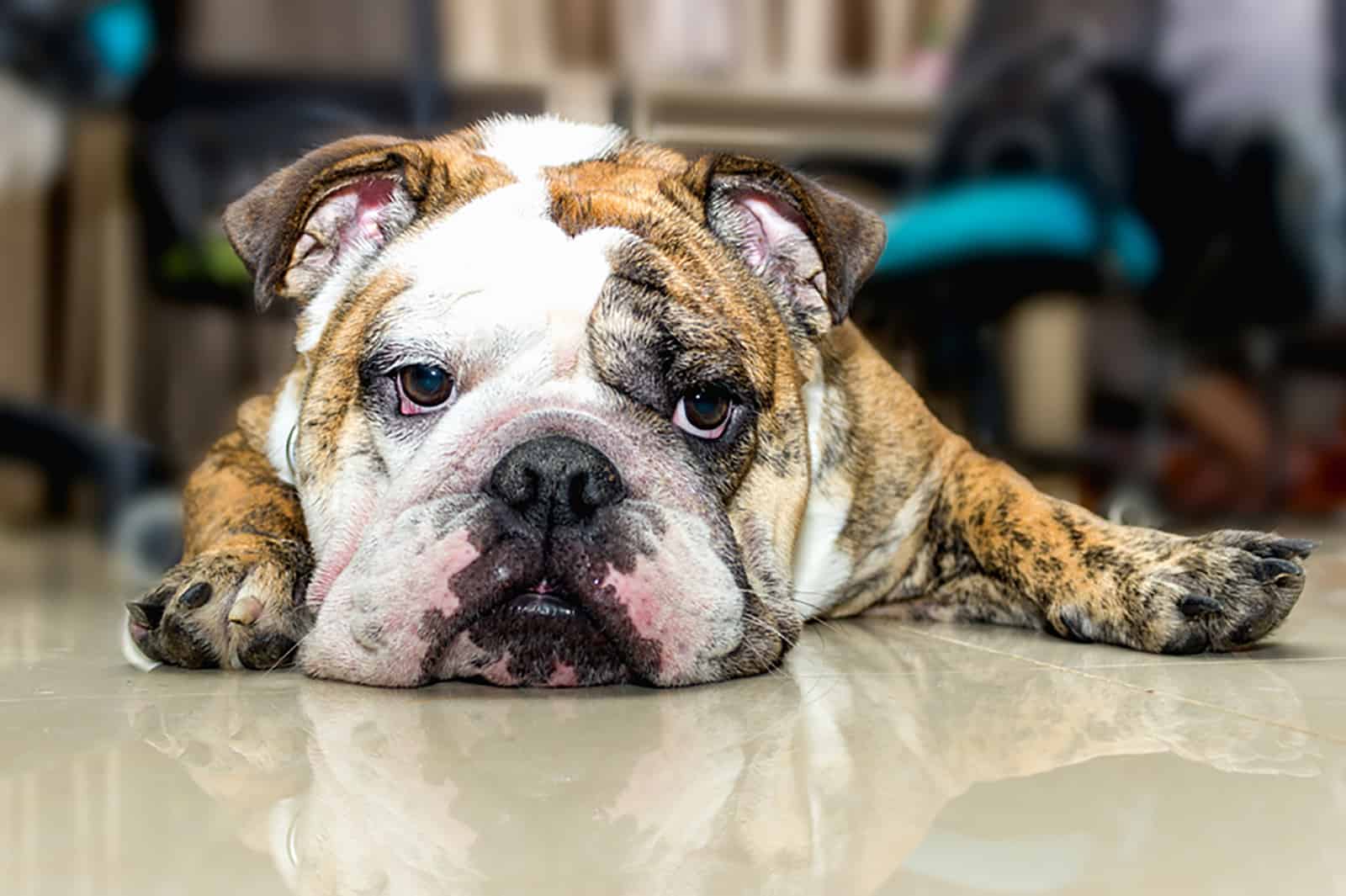
There are certain times when your pup might refuse to eat any food for more than one day, which is definitely a reason to be concerned and speak to a health professional.
There are a few potential causes that might be reasons why your pet is suddenly not interested in food anymore.
First, if you just got your puppy, and it’s still getting used to the new environment and humans around it, the pup might be hesitant to eat until it feels more at ease. This is quite a normal reaction, and isn’t a reason for concern.
There is always a risk that your new puppy won’t enjoy the food, but given that English Bulldogs are known for their voracious appetites, this is a very remote possibility.
The best way to prevent this from happening is to get the food that the breeder/previous owner fed him. This way, it’ll be easier for the doggie to get used to the new home and the food.
If your puppy hasn’t eaten in more than 24 hours, you should take it to the vet for an examination as soon as possible.
Wrapping Up
The main point of this English Bulldog Feeding Chart is to help you understand your new pet and its eating habits in a better way.
English Bulldogs are great family pets just as much as Golden Retrievers, Rotties, Aussies, and other dog breeds, although English Bullies might be more on the expensive side, especially when it comes to medical and food costs.
Feeding routines and eating habits are an essential part of the English Bulldog’s overall development no matter whether it’s a mini English Bulldog, an English Bulldog cross, or a purebred pup.
If you want to decrease the risk of your pup getting any food-related health issue, make sure to only get the best for your pup.
It can be Royal Canin Bulldog food or anything else that provides them with enough nutrients. Most commercial food can be found online on Amazon, Chewy, or other shopping sites.
READ NEXT:
How Long Does It Take For A Dog To Gain Weight?
How Heavy Should My Dog Be? A Guide To A Fit & Healthy Pup
38 Bully Dog Breeds That Can Be Great Family Pets
Best Bulldog Beds For Optimal Sleep And Healthy Development!
